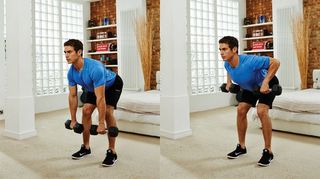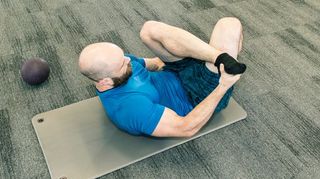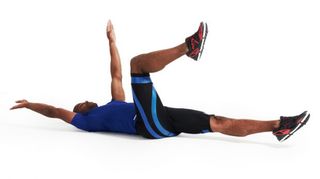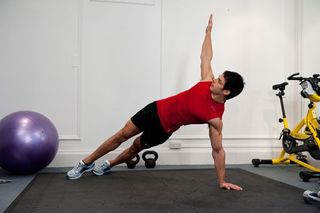Stop Training Like a Bro, Bro
More women than ever are lifting weights – so why on earth are you not doing more traditionally “ladylike” workouts?

Fun fact: Pilates, now commonly regarded as that core routine that’s probably a shade too gentle for Gwyneth Paltrow, was actually invented by a boxer/wrestler/strongman teaching self-defence to inmates in a First World War internment camp.
Bikram yoga, meanwhile, can actually increase your deadlift (by 13% in already-healthy participants, in case you’re wondering) according to a study from the Journal Of Strength And Conditioning Research. And ballerinas, apart from having vertical jumps comparable to some NFL players, regularly balance themselves on two toes. Two.
The lesson? If you’re still confining your gym activities to the bench and the squat rack, you’re missing out on myriad ways to make yourself stronger, healthier and more capable. And by addressing a few of the areas that female gym-goers often target, you’ve got every chance of blasting through your current plateaus and making serious gains. Here’s where to start.
Work Your Glutes
It’s a must for female figure contestants – but for the gents, not so much. “Most guys are under the impression that a few sets of squats and deadlifts are all the lower-body training they need,” says strength and conditioning coach Bret Contreras. “But targeting your glutes will make you better at running, jumping and most sports, as well as lifting.”
The catch? Your central nervous system probably doesn’t even bother activating your glutes for most moves, since you’ve put them to sleep with years of sitting down. But there’s good news: according to a 2016 study, just six days of targeted glute training can alter how much your glutes fire during a workout, letting you lift heavier - and harder. Here’s the Contreras prescription.
Banded fire hydrant
You might have seen this in the video to Nicki Minaj’s “Anaconda” – and with added resistance, it’s a wake-up call for under-used glutes. Wrap a band around both knees, then raise your knee to the side, like a dog at a fire hydrant. Repeat for 60 seconds on each side.
Plate hip bridge
Lie with your shoulders on a bench and a plate across your hips, your feet on the floor. Lower until your glutes touch the ground and then drive back up. Repeat for four sets of 20 reps.
Get the Coach Newsletter
Sign up for workout ideas, training advice, reviews of the latest gear and more.
American deadlift
“This is like the Romanian deadlift, but you add a glute squeeze at the top,” says Contreras. Hold a bar with your arms shoulder-width apart, then bend forward, keeping a neutral arch in your spine and a slight bend in your knees. When you feel a stretch in your hamstrings, straighten up and squeeze your glutes at the top of the move.
Lift with Less Ego
True, some ladies could stand to lift more – but should you be lifting less? Tackle your workout correctly and you might find it’s possible to drop the weight on every move you do but get bigger gains in the process. And self-limiting exercises (moves that fall apart if you do them with bad form or no control) can help you get there. “Used correctly, self-limiting exercises improve poor movements and maintain functional movement quality,” explains movement coach Gray Cook. “These exercises are challenging and produce a high neural load, which is to say they require engagement and increased levels of motor control at the conscious and reflexive level.” Or to put it another way, you’ll move better and recruit the right muscles.
Goblet squat halo
Holding a kettlebell by the handle with both hands, squat down until you can touch the insides of your knees with your elbows, then stand up. With the same grip, circle the kettlebell around your head. Don’t let your spine come out of alignment at any point. Do five slow reps.
Half-Kneeling Bottoms-Up Press
Kneel on one knee, holding a (light) kettlebell by the handle in your opposite hand with its base facing up. Press it overhead, pause, then lower slowly. The limiter here is strength and technique: you won’t be able to press the bell with bad alignment, and the kneeling position will stop you from powering it up with leg strength. Do three reps a side
Single-leg deadlift
Still holding the kettlebell in one hand, stand on the opposite leg and bend forward, hingeing at the hips, keeping a neutral arch in your spine. Pause as you feel a stretch in your hamstring, then straighten up. Do five reps on each side.
Lift Light, Lift Better
Still cheating your way to big numbers on the gym classics? Lower the weight, improve the form - and help your gains
Biceps curl
Step away from the 50s, bro: with perfect form, your Argos spinlock set is enough. Squeeze your biceps as hard as possible at the top of the move, lower for a four-count and squeeze your triceps hard at the bottom. Repeat to near-failure for three sets, and embrace that pump.
Bent-over row

Using dumbbells promotes better range of motion, so your shoulders will benefit as much as your back. Bending forward at the hips, raise the dumbbells until they touch your ribs, pausing at the top with your elbows retracted. Lower under control.
Reverse lunge
It’s harder to cheat this one than the traditional forwards version, plus it puts less stress on your knees. Holding your dumbbells, take a big step backwards into a lunge, so that your front shin stays vertical. Push back off, stand up straight, and repeat on the other side.
Improve Your Flexibility
Be honest: you know you should spend more time on this than that cursory quad stretch while you’re waiting for the squat rack but you don’t have time to spend half an hour on elaborate figure-four stretches every workout. The solution? Focus on a simple, repeatable set of bang-for-your buck exercises, targeted where you most need them.
“Many of us have issues with tight, dysfunctional hips,” says Jarlo Ilano of gymnastics programme Gold Medal Bodies. “Working on them consistently for a while will give you a base for good movement.” Start doing the three moves here daily: move in and out of the “stretched” position ten times, hold for 30 seconds, then shake it off and repeat once. Remember, better depth in your lunges and squats means more muscular recruitment - and more growth.
Kneeling lunge
Get into a kneeling lunge with your hips square and your upper body upright, then pull your back foot in towards your glutes. Keep your front shin vertical throughout the stretch.
Piriformis stretch

Lie on your back with one leg crossed over the other, then shift your hips as far over as possible, pulling your knee to your chest. Try to find a spot that doesn’t cause any unnecessary tension in your knee.
RECOMMENDED: We Learn a Thing or Two at Barrecore
Frog stretch
Kneel with your knees wide apart so you feel a stretch in your groin. Try to “pull” your knees together as you rock backward, and relax as you rock forward. Once you’ve warmed up, hold the “back” position for a solid 30 seconds.
Do Creative Core Work
Hopefully it won’t be news to you that sit-ups aren’t the miracle abs solution you need. But is whatever you’re doing instead actually that much better? “Guys tend to find ways to bring their hip flexors into the movement on a whole slew of moves that are supposed to be working their abs,” says personal trainer Jessica Wolny. “Even moves like hanging leg raises aren’t immune. But by incorporating moves from Pilates and gymnastics, you’ll ensure that you isolate your abs - and actually make them work.” Ready for your first ever real abs workout?
Boat
It’s a yoga staple, and it isn’t easy. Sit with your legs slightly raised off the ground and your back at a roughly 60° angle to the floor, with your hands reaching forward and palms facing in. Hold it for 15 seconds, rest for 15, and repeat three times.
Bird dog

Get on your hands and knees, then lift one leg off the floor and straight behind you and lift the opposite arm to point straight ahead. Alternate sides every 15 seconds until you’ve done 60 seconds on each side.
Dead bug

This Pilates classic defies cheating. Lie on your back with your arms and fingers pointing straight up, with your legs raised and bent 90°. Lower one arm and the opposite leg slowly until they’re parallel to the floor - it should take at least five seconds to lower and return - and then repeat on the other side. Do the whole thing three times, making sure your back doesn’t leave the floor.
Pallof press
Most moves work flexion, but working with rotation (or against it) will make you strong from every angle. Hold a cable against your chest so it extends at right angles from your arms - it should feel as if it’s going to tug you around in a circle. Slowly extend your arms, then bring them back to your chest. Repeat for five reps on each side.
Be More Mobile
It’s the new stretching - except that where your pre-five-a-side toe touches just work the muscle, mobility work aims to address your ligaments, tendons, fascia and joints. And if that sounds a bit too candlelit-yoga for your tastes, consider that MMA fighters and NFL players are finding just as much value in mobility work as people whose most hazardous activity is the school run.
For the deskbound modern man, of course, the biggest problem is the office-drone slouch: sitting with a bent upper back, slumped shoulders and a neck that juts out, which causes tight traps, pecs and (sometimes) upper abdominal muscles. Use this mini-circuit, courtesy of strength coach Chad Waterbury, to make a start on fixing it.
Wall slide
Stand against a wall and hold your hands up against it like you’re being held up by desperadoes. Keeping your upper arms in contact with the wall, slowly slide them upwards to a full stretch, then back down. Repeat for two sets of five.
Waterbury crucifix
Grab a couple of very light weights - even water bottles will do - and bend forwards at the hips, then raise the weights to your sides with your arms straight. Aim to hold the position for two minutes, focusing on pulling your shoulder blades back throughout the move.
T press-up

Done with proper form, this move will teach your body to use its new shoulder stability effectively. Start in a normal press-up, then as you press, turn your body to one side and raise your arm towards the ceiling. Repeat on the other side, until you’ve done five reps on both.
Analyse Your Workout
“Just train harder, bro” will work for a while, but sooner or later you’re going to hit a wall. That’s where tracking progress comes in. “A lot of guys seem to be against carrying a notepad to the gym but to me, it means you care, and want to improve,” says PT and trainee stuntwoman Kerry Tanner. “If I’m feeling fuzzy or struggle during a session, I turn to my tracker. By evaluating what went well or badly, I’ll know what to focus on.” Make the below your go-tos.
Hydration
“I fill up a two-litre bottle and finish it by the end of the day, with another two litres if I train and sweat lots,” says Tanner. “I know I haven’t drunk enough if I go into slow motion on the treadmill before my weights session. It doesn’t happen often, but it would if I didn’t track my intake.”
Nutrition
It’s about more than just carbs and protein. “It’s about digestion - and what works and what doesn’t work goes in my training journal,” says Tanner. “If I feel bloated after a particular type of food or drink, I won’t eat it again pre-workout - and I’ll be careful about using it for recovery.”
Sleep
“If you aren’t well rested, your body won’t recover from one session to the next,” says Tanner. “Make sure you give yourself a sleep routine and wind down - this is something women are good at. Record how long you sleep for and, if you can, make a note or two about sleep quality - you’ll probably notice it correlates to a good session.”
Lifts
Tracking what you lift in each session will let you do more than remember your PBs: it’ll show patterns in how you train. “Take note of what time you trained and what you did in your warm-up,” says Tanner. “You’ll see patterns that provide clues as to what brings out the best in you.”
Body composition
“Since weight fluctuates in women a lot more than with men, it can be a psychological minefield from one day to the next,” says Tanner. “A good body fat scanner can help you stay on track.” DEXA scans are the gold standard, but body fat scales or the Skulpt Chisel gadget can also work.
From 2008 to 2018, Joel worked for Men's Fitness, which predated, and then shared a website with, Coach. Though he spent years running the hills of Bath, he’s since ditched his trainers for a succession of Converse high-tops, since they’re better suited to his love of pulling vans, lifting cars, and hefting logs in a succession of strongman competitions.

